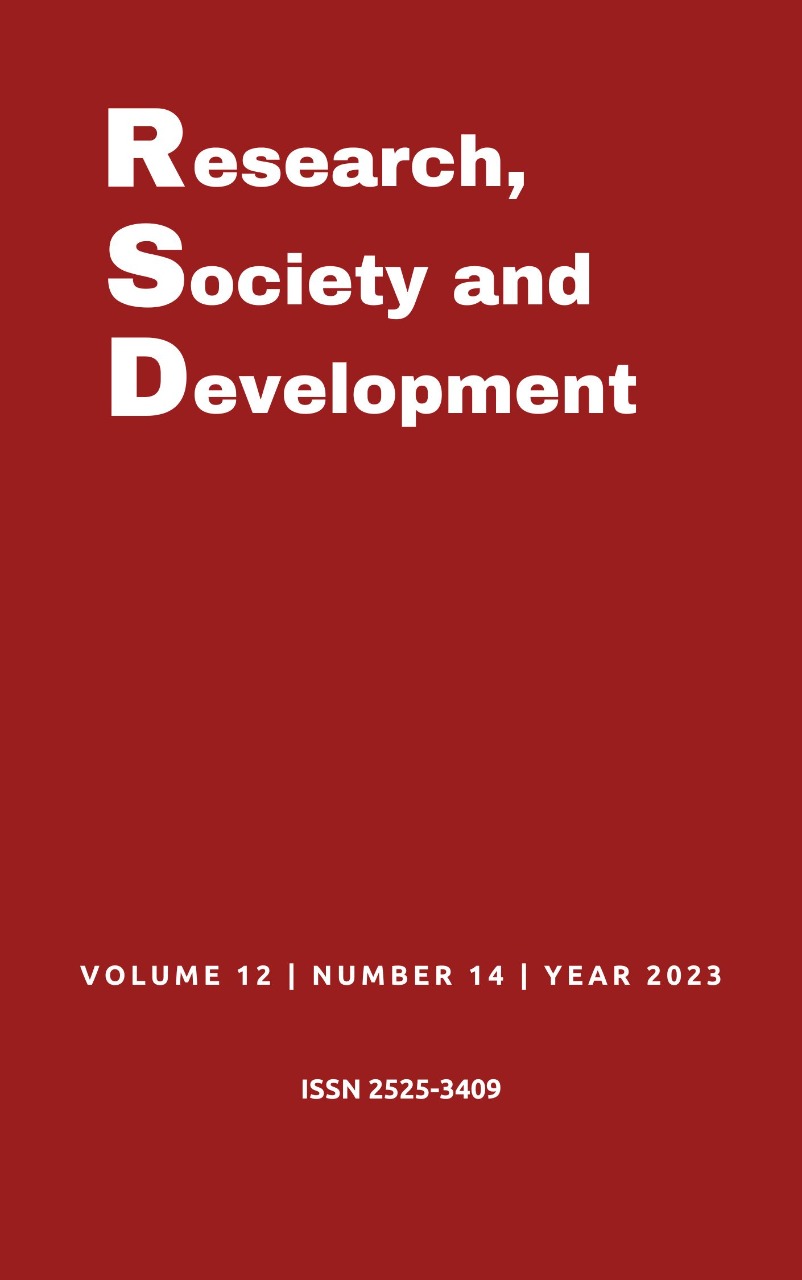Comparison of specific methods for risk assessment of nanomaterials in research laboratories
DOI:
https://doi.org/10.33448/rsd-v12i14.44520Keywords:
Occupational risk assessment, Nanomaterials, Control banding.Abstract
Nanomaterials (NMs) can exhibit physical, chemical, and biological properties different from their counterparts at the micro or larger scale, molecular, or atomic level. Altering these properties may modify or intensify the toxicological effects of NMs on living organisms and the environment. The distinct properties of NMs have expanded their potential applications in various technological areas, leading to a significant increase in production. Consequently, the number of researchers exposed to NMs in laboratories has also increased. The aim of this study is to identify the most suitable method for assessing occupational risks in research laboratories working with nanomaterials. To achieve this, risk assessment methods focusing on control through risk levels (control banding - CB) were selected and applied to research laboratories in three different tasks (processes), and the results were compared. In general, there is convergence between the methods regarding their results for each of the studied tasks. However, under these conditions, only one method met both comparison criteria: CB IMEC.
References
Andrade, L. R. B. (2013). Sistemática de ações de segurança e saúde no trabalho para laboratórios de pesquisa com atividades de nanotecnologia. Tese de Doutorado. Universidade Federal do Rio Grande do Sul. CB SST/LabNano. https://lume.ufrgs.br/handle/10183/96396
Arcuri, A. S. A. & Pontes, J. M. (2018). Nanotecnologia e seus impactos na saúde, meio ambiente e no mundo do trabalho. in: Hess, S.C. (Org.), Ensaios sobre poluição e doenças no Brasil. (pp. 315–336). Outras Expressões.
Batista, L. dos S. & Kumada, K. M. O. (2021). Análise metodológica sobre as diferentes configurações da pesquisa bibliográfica. Revista Brasileira de Iniciação Científica, 8, e021029. https://periodicoscientificos.itp.ifsp.edu.br/index.php/rbic/article/view/113
Buzea, C. & Pacheco, I. (2019). Toxicity of nanoparticles. In: Pacheco-Torgal, Fernando et al (Ed(s)), Nanotechnology in Eco-efficient Construction. (pp. 705–754). Elsevier. https://doi.org/10.1016/B978-0-08-102641-0.00028-1
Canuto, L. T., & Oliveira, A. A. S. D. (2020). Métodos de revisão bibliográfica nos estudos científicos. Psicologia em Revista, 26(1), 83–102. https://doi.org/10.5752/P.1678-9563.2020v26n1p82-100
Duuren-Stuurman, B. Van, Vink, S. R., Verbist, K. J. M., Heussen, H. G. A, Brouwer, D. H., Kroese, D. E. D. & Fransman, W. (2012) Stoffenmanager nano version 1.0: Aweb-based tool for risk prioritization of airborne manufactured nano objects. Annals of Occupational Hygiene,56 (5) 525–541. https://doi.org/10.1093/annhyg/mer113
El-Kady, M. M., Ansari, I., Arora, C., Rai, N., Soni, S., Verma, D. K., Singh, P., & Mahmoud, A. E. D. (2023). Nanomaterials: A comprehensive review of applications, toxicity, impact, and fate to environment. Journal of Molecular Liquids, 370, 121046. https://doi.org/10.1016/j.molliq.2022.121046
EU Commission. (2013). Guidance on the protection of the health and safety of workers from the potential risks related to nanomaterials at work. Guidance for employers and health and safety practitioners. https://www.google.com/url?sa=t&rct=j&q=&esrc=s&source=web&cd=&ved=2ahUKEwiMp9qByfaCAxWFpJUCHe9QC8IQFnoECBcQAQ&url=https%3A%2F%2Fec.europa.eu%2Fsocial%2FBlobServlet%3FdocId%3D13087%26langId%3Den&usg=AOvVaw3-mxnBeF0K7X37bqWi0utk&opi=89978449
European Agency for Safety and Health at Work. (2009). New and emerging risks in occupational safety and health. https://osha.europa.eu/sites/default/files/en_te8108475enc.pdf
European Agency for Safety and Health at Work. (2019). Manufactured nanomaterials in the workplace. https://osha.europa.eu/en/publications/info-sheet-manufactured-nanomaterials-workplace
Fundação Jorge Duprat Figueiredo de segurança e medicina do trabalho. (2018). Nota Técnica 01/2018: Os desafios da saúde e segurança no trabalho (SST) para uma produção segura com o uso de nanotecnologia. http://antigo.fundacentro.gov.br/arquivos/projetos/Nota%20tecnica%20%2001-2018%20Corrigida%20e%20Revisida.pdf
GoodNanoGuide. 2009.(2023). CB GoodNanoGuide. https://nanohub.org/groups/gng.
International Organization for Standardization.2014. Nanotechnologies – Occupational Risk Management Applied to Engineered Nanomaterials – Part 2: Use of the Control Banding Approach (ISO/TS 12901-2). https://www.iso.org/standard/53375.html
Jensen, K. A. (2016). NanoSafer v. 1.1beta. http://www.nanosafer.org
Organização Internacional do Trabalho. (2010). Riesgos emergentes y nuevos modelos de prevención en un mundo de trabajo en transformación. https://www.ilo.org/wcmsp5/groups/public/@ed_protect/@protrav/@safework/documents/publication/wcms_124341.pdf
Organisation for Economic Co-operation and Development. (2019). Pysical-chemical decision framework to inform decisions for risk assessment of manufactured nanomaterials. https://one.oecd.org/document/env/jm/mono(2019)12/en/pdf
Organização Mundial da Saúde. (2017). WHO Guidelines on Protecting Workers from Potential Risks of Manufactured Nanomaterials. https://www.ncbi.nlm.nih.gov/books/NBK525054/pdf/Bookshelf_NBK525054.pdf
Ostiguy, C., M. Riediker, J. Triolet, P. Troisfontaines, D. A. Vernez & A. M. (2010). Development of a Specific Control Banding Tool for Nanomaterials: ANSES Report. https://www.anses.fr/en/system/files/AP2008sa0407RaEN.pdf
Paik, S. Y., Zalk, D. M. & Swuste, P. (2008) Application of a pilot control banding tool for risk level assessment and control of nanoparticle exposures. Annals of Occupational Hygiene, 52 (6), 419–428. https://doi.org/10.1093/annhyg/men041
Sajid, M. (2022). Nanomaterials: Types, properties, recent advances, and toxicity concerns. Current Opinion in Environmental Science & Health, 25, 100319. https://doi.org/10.1016/j.coesh.2021.100319
Simeone, F. C., Blosi, M, Ortelli, S. & Costa, A. L. (2019) Assessing occupational risk in designs of production processes of nano-materials. NanoImpact, 14, 100149.https://doi.org/10.1016/j.impact.2019.100149
StatNano. (2023). Nanotechnology Products Database. http://product.statnano.com.
Van Hoornick, N., Prodanov, D. & Pardon, A. (2017) Banding approach for engineered nanomaterial risk assessment and control. Journal of Physics: Conference Series, 838(1),1-7. https://10.1088/1742-6596/838/1/012017
Downloads
Published
Issue
Section
License
Copyright (c) 2023 José Renato Alves Schmidt; Arline Sydneia Abel Arcuri ; Luís Renato Balbão Andrade ; Maria de Fátima Torres Faria Viegas ; Valéria Ramos Soares Pinto

This work is licensed under a Creative Commons Attribution 4.0 International License.
Authors who publish with this journal agree to the following terms:
1) Authors retain copyright and grant the journal right of first publication with the work simultaneously licensed under a Creative Commons Attribution License that allows others to share the work with an acknowledgement of the work's authorship and initial publication in this journal.
2) Authors are able to enter into separate, additional contractual arrangements for the non-exclusive distribution of the journal's published version of the work (e.g., post it to an institutional repository or publish it in a book), with an acknowledgement of its initial publication in this journal.
3) Authors are permitted and encouraged to post their work online (e.g., in institutional repositories or on their website) prior to and during the submission process, as it can lead to productive exchanges, as well as earlier and greater citation of published work.


